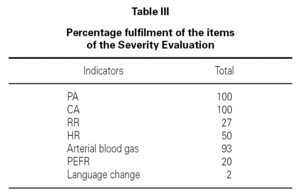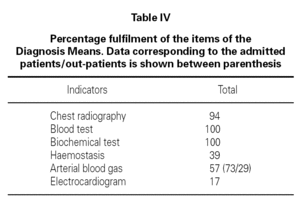INTRODUCTION
Over the last decade, International Consensus has appeared based on experts, (GINA) about medical care for patients affected by Bronchial Asthma in an integral way and about the actions taken to face a specific asthma crisis.
Several Scientific Societies have also drafted Clinical Guides destined for internal use (British, American, Spanish) 1. and in the end, numerous hospitals, in accordance with their specific health care environments, have prepared their own action protocols in the corresponding Accident and Emergency Departments 2.
Unfortunately, there are a few conflicting facts as well as good reasons to believe that these Guides or recommendations are carried out in an inadequate way and we cannot be certain if they will produce better clinical results than other action procedures.
In our country, there are very few studies about the evaluation of daily practice by means of the aforementioned Medical Audits, in this case, in the medical care for an acute asthma attack. For this reason, we proposed carrying out a medical audit about the medical care provided in the Accident and Emergency Department of our hospital to adult patients that were admitted due to acute asthma crisis and to consequently detect the improvement areas well as potential improvement proposals.
METHODS
The data collection phase took place from September 2002 to January 2003 in the La Fe University Hospital. The sample was obtained by means of a random review at a fixed rate for the Hospital Admission lists, in which the diagnosis records of each patient were registered in the Emergency Room Door. The study excluded the vacation period corresponding to the Christmas holidays. The hospital's medical history documentation, including the copy of the discharge report of all the adult patients (which means, above the age of 14), which had been discharged or admitted with the diagnosis of asthma crisis. The on-duty personnel were not informed until the conclusion of the data collection phase.
The data was collected by a single evaluator (TL) by means of a work sheet designed for this purpose, thus guaranteeing the anonymity of the patients. The Emergency Room lists corresponding to the on-duty days of any of the researchers were discarded. In comparison with equivalent studies, it was decided to obtain figures from 50 clinical cases or processes.
Following the methodology of the Medical Audit 3, explicit and objective indicators were established, with a dichotomous response, except those that made reference to medication dosage, based on the review by the authors of the International Consensus to manage asthma crisis, of the recommendations issued by the Accident and Emergency Department of our hospital and "benchmarking" similar studies published in scientific literature.
The indicators are classified in 4 blocks: 1) Prior clinical evaluation; 2) Severity Valuation of the crisis; 3) Diagnosis means; 4) Treatment and Discharge Conditions in the Accident and Emergency Department (table I).
Once the data was collected and tabulated, they were subjected to analysis sessions with their corresponding evaluation, focusing on the aspects that represented Improvement Areas and the elaboration of realistic Improvement Alternatives. This data was transmitted to the Hospital's Management team by means of the Quality Management Department.
RESULTS
48 episodes of asthma attacks were collected corresponding to 46 patients treated in the Accident and Emergency Department, which resulted in 30 hospital admissions. No admission was recorded in the Intensive Care Unit (ICU) and no exitus occurred. There was not any recorded readmission in our centre due to asthma for the patients remitted to their homes.
The percentage fulfilment of the block items of the Clinical Evaluation are shown in table II, where data corresponding to the admitted patients/out-patients is shown between parenthesis, where significant differences were detected for the fulfilment between both patient groups. The Indicators are observed which are collected in high percentages: record of diagnosis (87 %), medical history of asthma crisis (90 %) whereas other indicators such as the graduation of the severity (32 %), the prior duration (27 %), the causing factor (54 %) are recorded in a lower number of cases.
The severity indicators, shown in table III, were collected in a very irregular way. The fulfilment for the Respiratory Rate (RR) (27 %), Heart Rate (HR) (50 %), PEFR usage (20 %) was scarce, whereas in the total amount of the cases, the pulmonary (PA) and cardiac (CA) auscultation was determined. In several medical histories analyzed (4 %), there was a doctor's note about the non-performance of this measure due to the inexistence of Peak Expiratory Flow rate measurement devices at that time in the Accident and Emergency Department.
In relation to the diagnosis means used, table IV, the chest radiography was carried out for 94 % of the patients, which means it was performed in all cases, except two, due to pregnancy. A blood test and biochemical test were requested in all cases (100 %), the arterial blood gas analysis in 57 % of the medical histories (73 % of the admitted patients and 29 % of the out-patients discharged to their homes), the electrocardiogram was carried out in 17 % and a haemostasis study in 39 % of the cases.
In relation to the administered treatment, 12 % of the patients did not have any type of treatment recorded in their medical history. All the treated patients received nebulised β2-agonist, 80 % parenteral corticoids (62/18 admitted/out-patients), 60 % received oxygen, in 16 % of them, it was administered by a Ventimask type mask. With regards to the profile of the corticoid treatment administered, two types of parenteral corticoids were used, methylprednisolone (42 %) and hydrocortisone (58 %), using different dosages, from 40 to 80 mg of prednisolone (40 mg in 85 % of the cases) and from 100 to 1000 mg of hydrocortisone, (300 mg in 60 % of the cases). In 10 % of the medical histories evaluated, there was no written record of the established dosage. In relation to the outpatients discharged to their home, 77 % recorded an increase in the treatment, 6 % were discharged with the same treatment, and 11 % discharged without asthma crisis treatment, and 6 % did not record any type of treatment.
DISCUSSION
The results shown in this study indicate the scarce and irregular follow-up of the Clinical Guides of a general nature for the treatment of acute Asthma, as well as our local adaptation to these regulations. Once again, this clearly shows the gap between the recommended regulation and the common practice. The results are not homogenous, where certain items are fulfilled in 100 % of the cases (CA, PA), and others in very low proportions such as the case with the PEFR (20 %). There appears to be greater fulfilment in the case of admitted patients, than the out-patients discharged to their home, presumably with lower severity. This situation was reported by other studies 4.
It is striking the scarce determination of the severity of the crisis, a fact on which the subsequent medical treatment, in theory, must be based. Furthermore, several of the items, which are determining factors to define the severity of the crisis such as the RR, were collected in very few cases. This is a potentially relevant fact, if as sustained by some authors such as Mohan, the failure to establish the correct evaluation of the severity is one of the factors that is related to death by asthma 5.
It must be mentioned in the case of the PEFR registers, with this fact being understood, at least partially, as an infrastructure equipment deficit, as deduced by the comments from several doctors about the impossibility to carry out Peak Expiratory Flow measurements due to the absence of these devices in the Emergency Rooms. It is unanimously accepted that the PEFR determinations are a good indicator of the clinical response to the treatment 6.
It is very difficult to justify the highly frequent use of certain diagnosis means such as blood test, chest radiography, or haemostasis in an apparently automatic way, such as those that can be due to specific clinical conditions of comorbidity, which would indicate a certain routine in the work of medical personnel. For instance, no international or local consensus has been reached that includes a chest radiography as the mandatory study of all acute asthma, which is reserved for the most severe cases.
The treatment section is clearly irregular, both in the type of corticoid used as well as in the dosage. Generally, a single dosage of 40 mg of methylprednisolone is recommended for the initial treatment of acute asthma. Similar data in reference to the low usage of corticoids were previously published by other authors 7-9. On the other hand, it is difficult to accept the existence of patients discharged to their home for which no treatment has been recorded.
In 1994, a study was performed in our centre focused on comparing the medical care for acute asthma by pneumology specialists and the rest of the on-duty medical staff in the Accident and Emergency rooms 10 and the situation was detected at that time of the infringement of several parameters similar to the current ones.
Despite the fact that the Medical Audits were intended as a local study and not as inter-centre comparisons, in an overall way, our data demonstrates a better fulfilment of the guides than others that have been published 11 although clearly below other centres 2.
As a summary, the main deficits detected in our work are: the non-evaluation of the severity of the crisis, insufficient usage of Peak Expiratory Flow measurement-devices, excessive consumption of some diagnosis means, and the failure to record the medical treatment received or the treatment proposed for their discharge from the Emergency Department, as well as discharge forms whose manuscripts are impossible to read.
Following the basic principle of all Audits, we propose, among other measures, the availability of PEFR measurement-devices, the individualized use of diagnosis means, and the recommendation to create a more simple and practical protocol than the one currently used in our hospital and which is displayed in the form of a poster in the Accident and Emergency Room Department.
We understand that it is more appropriate to adopt a protocol as simple as that proposed by Mahavedan 9 based on three categories or possibilities: very severe, very minor, and an intermediate category.
After this work was written up, the remodelling of the Accident and Emergency Department took place in our Hospital, which included such measures as a greater number of PEFR measurement-devices, among others. Thus, it is also appropriate to consider the possibility of carrying out a Re-audit after a certain time has passed, to establish if these measures have been taken in relation to the deficits established in this study.
ACKNOWLEDGEMENT
The authors wish to express their gratitude to the enthusiastic help provided by Miguel Herraiz, Emilio Gosalbez, Ms. Amparo Torres, and Ms. Blanca de Pedro.
Correspondence:
A. Campos
Servicio de Alergia
Hospital Universitario La Fe
Avda. Campanar, 21
46009 Valencia. España
Tel.: 661617569
Fax: 961973089 (Especificar dpto. Alergia Dr. Campos)
E-mail: campos_ang@gva.es












